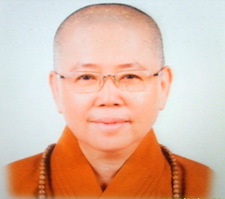
Bhiksuni Ming-jia
Taiwan
Venerable Bhiksuni Ming-Jia was born on June 20, 1951 in Kaohsiung City, Taiwan. At the age of 15, she became a lay Buddhist with Venerable Chan Yun, studied with Venerable Bhiksuni Jing Kong and later became a student of Venerable Tian Yi.
In 1969, she went to study at National Kaohsiung Normal University in the Department of Chinese Literature, and soon became the 3rd President of the Dai-Hui Buddhist Society. Through her great leadership, she inspired many people to study the Buddhist Sutras. To cope with this rapid Buddhist learning, the Dai-Hui Journal was founded and published.
Bhiksuni Ming-Jia, as a young lay woman, entered the Southern Taiwan Buddhist Dharma Speaker’s Contest and won the championship. During her college days she also organized Buddhist Camps for: children, women, students. In addition, she organized various Buddhist activities for college students at major temples, such as the Chan-Lin Temple and Meishan Glong-Fa Temple in Kaohsiung.
In 1973 she began her teaching career at Kaohsiung Municipal Da-Yi Junior High School, and after two years was awarded for being an Excellent Role Model Teacher.
In 1977, Venerable Ming-jia ordained as a Samani, and in 1979 received her full ordination with Bhiksuni and Bodhisattva Vows. Thereafter, she resided at the Luminary Temple in Zhuqi Township, Chiayi County. Her dream and strength increased and she founded the Luminary Buddhism Center with Venerable Wuyin and Venerable Xinzhi, and Buddhist education for Bhiksunis and lay people began to improve with sufficient energy to create the Glorius Buddhist Magazine, and the Zizhulin Vihara.
Motivated by the belief that modern business management practices could transform traditional Buddhist temples to be of greater benefit to people, Venerable Bhiksuni Ming-jia travelled to the USA to pursue a Master of Business Administration. While there she founded the American Evergreen Buddhist Association to bring Buddhism to the local Chinese population. In 1991 she received her M.B. A. degree from City University in Seattle, WA, USA.
In 1992 she became the abbess of the Luminary Temple. Thereafter, she served as a Witness Acariya for 3 higher ordinations at Miao-Fa Temple. All the while she kept building Luminary Temple which was completed in 1996, and the smooth management style of the temple facilitated a steady offering of Dharma courses.
In 1996 she studied Vipassana meditation with Ajahn Goenka in India, and subsequently became Taiwan’s first Vipassana meditation teacher. In 1996 she also founded the Chinese Buddhist Bhiksuni Association along with 23 other Bhiksunis. They set an agenda to improve the education of Bhiksunis. In 1997 she met with His Holiness the 14th Dalai Lama of Tibet when His Holiness came to Taiwan. Together with other Bhiksuni,s they met His Holiness and discussed the Taiwanese Bhiksuni system of training.
In 2000 Venerable Bhiksuni Ming-jia began to establish Taiwan’s first Vipassana Meditation Center, and she stepped down as the Abbess of the Luminary Temple. In 2003 Goenka bestowed upon her the area responsibility of Taiwan and the higher expectation that she will promote Vipassana to all Chinese around the world.
In 2003 she began to reside at Manjusri Vihara in Tainan. She steadily improved the programming: monthly group meditation sittings, Buddhist study courses, and she taught Vipassana to the public. In 2007 she returned to the USA and helped the Washington-based Sravasti Abbey to strengthen its Bhiksuni Sangha. In 2011 she became the Executive Director of the Tainan City Buddhist Association. Before that she had been the Director of the Chiayi County Buddhist Association.
In 2011 she opened the 2nd Vipassana Center. This one located in Liouguei, Kaohsiung. It offers long-term courses. In 2012 the Chinese Buddhist Association invited her to be the host master of a ceremony for removing disasters and increasing merits.
Venerable Bhiksuni Ming-Jia of Taiwan now sets her goal to build an International Vipassana Institute in Taiwan.